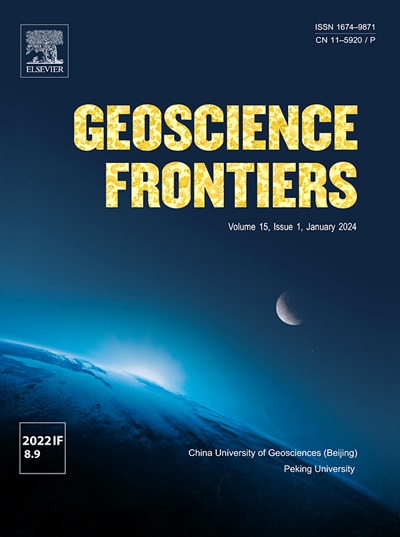Palynofloral and geochemical evidence for Permian-Triassic transition from Talcher Coalfield, Son-Mahanadi Basin, India: Insights into age, palaeovegetation, palaeoclimate and palaeowildfire
IF 8.9
1区 地球科学
Q1 GEOSCIENCES, MULTIDISCIPLINARY
引用次数: 0
Abstract
The Permian-Triassic (P/T) transition is marked by the most severe mass-extinction event of the Phanerozoic. Although much is known about this event in the marine realm, there are many open questions regarding what happened during this period to many continental biota. In the case of plants, a drastic mass-extinction event has even been negated by some authors. To add about the knowledge on continental biota in India during this crucial time period, the present study analysed the palynology, palynofacies, organic geochemistry (biomarkers), stable isotopes, and charcoal within the subsurface Gondwana deposits of the Kamthi Formation (late Permian-early Triassic) from core TTB-7 from the Tribida block, located in the Talcher Coalfield of the Mahanadi Basin, India.
The primary objectives are to validate the age of the strata, ascertain the palaeodepositional setting of the palaeomire, and propose palaeobotanical evidence regarding the occurrence of wildfires within this stratigraphic succession and changes in floral content across the P/T transition. The palynological study proposes two palynoassemblage zones, Densipollenites magnicorpus and Klausipollenites schaubergeri, suggesting a latest Permian (Lopingian) and early Triassic (Induan?) age for the studied succession, respectively. The age is also inferred based on correlation with coeval assemblages from India and other Gondwana continents. The palynoassemblages reveal the dominance of Glossopteridales and Coniferales along with Filicales, Lycopsidales, Equisetales, Cordaitales and Peltaspermales. The relatively higher values of the carbon preference index and terrigenous/aquatic ratio also suggest higher plant input. However, a bimodal n-alkane distribution pattern suggests the contribution of terrigenous and microbial sources. Although the occurrences of long-chain alkanes indicate input of higher plants, the low Pwax values (<0.26) suggest relatively less contribution. The Paqvalues (≅1) and amorphous organic matter (av. 33.24%) suggest a significant macrophyte input in the studied samples, pointing to the occurrence of moderate aquatic conditions in the basin.
Furthermore, the distribution of hopanoids and the content of degraded organic matter (av. 29.96%) reflect the bacterial degradation of organic matter. Also, the δ13C values of the studied section varied from −31.2‰ to −21.8‰. A large carbon isotopic offset of 9.4‰ across the P/T transition, Pr/Ph ratio (0.3–1.3) and shift in the distribution pattern of palynofacies components is indicating a significant change in climatic conditions. Moreover, the presence of macroscopic charcoal fragments of gymnospermous affinity with pre-charring colonization by fungi provides evidence for wildfire occurring during the Lopingian (Late Permian) in this basin.

印度Son-Mahanadi盆地Talcher煤田二叠纪-三叠纪过渡的孢粉植物和地球化学证据:对时代、古植被、古气候和古野火的见解
二叠-三叠纪(P/T)过渡以显生宙最严重的大灭绝事件为标志。虽然在海洋领域对这一事件了解很多,但关于这一时期许多大陆生物群发生了什么,仍有许多悬而未决的问题。以植物为例,一些作者甚至否定了剧烈的大规模灭绝事件。为了增加对这一关键时期印度大陆生物群的认识,本研究分析了位于印度Mahanadi盆地Talcher煤田Tribida地块TTB-7岩心的Kamthi组(晚二叠世-早三叠世)Gondwana地下矿床的孢粉学、孢粉相、有机地球化学(生物标志物)、稳定同位素和木炭。研究的主要目的是验证地层的年龄,确定古泥岩的古沉积环境,并就该地层演替中野火的发生以及整个P/T转换期间植物含量的变化提出古植物学证据。孢粉学研究提出了两个孢粉组合带,Densipollenites magnicorpus和Klausipollenites schaubergeri,表明所研究的演替分别为晚二叠世(Lopingian)和早三叠世(Induan?)。年龄也可以根据与印度和冈瓦纳其他大陆的同期组合的对比来推断。孢粉组合以舌科和松柏科为主,其次为丝科、石松科、马科、Cordaitales和peltaspermale。相对较高的碳偏好指数和陆源/水生比也表明较高的植物投入。然而,双峰型正构烷烃分布模式表明陆源和微生物源的贡献。虽然长链烷烃的出现表明高等植物的输入,但Pwax值较低(<0.26)表明贡献相对较小。Paqvalues(= 1)和无定形有机质(av. 33.24%)表明,研究样品中存在显著的大型植物输入,表明该盆地存在中度水生条件。此外,藿烷类化合物的分布和降解有机质的含量(29.96%)反映了细菌对有机质的降解作用。δ13C值在−31.2‰~−21.8‰之间变化。在P/T转换过程中,碳同位素偏移量达9.4‰,Pr/Ph比值为0.3 ~ 1.3,孢粉相组分分布格局发生变化,表明气候条件发生了显著变化。此外,裸子植物亲和性和真菌预炭化定植的宏观木炭碎片的存在为该盆地洛平纪(晚二叠世)发生野火提供了证据。
本文章由计算机程序翻译,如有差异,请以英文原文为准。
求助全文
约1分钟内获得全文
求助全文
来源期刊

Geoscience frontiers
Earth and Planetary Sciences-General Earth and Planetary Sciences
CiteScore
17.80
自引率
3.40%
发文量
147
审稿时长
35 days
期刊介绍:
Geoscience Frontiers (GSF) is the Journal of China University of Geosciences (Beijing) and Peking University. It publishes peer-reviewed research articles and reviews in interdisciplinary fields of Earth and Planetary Sciences. GSF covers various research areas including petrology and geochemistry, lithospheric architecture and mantle dynamics, global tectonics, economic geology and fuel exploration, geophysics, stratigraphy and paleontology, environmental and engineering geology, astrogeology, and the nexus of resources-energy-emissions-climate under Sustainable Development Goals. The journal aims to bridge innovative, provocative, and challenging concepts and models in these fields, providing insights on correlations and evolution.
 求助内容:
求助内容: 应助结果提醒方式:
应助结果提醒方式:


